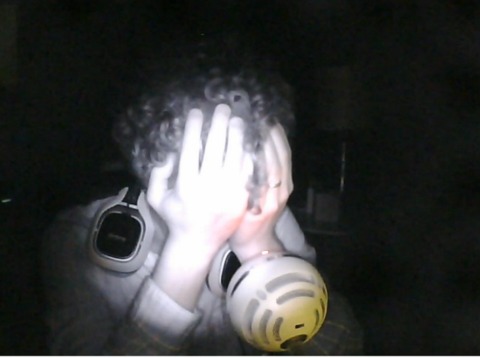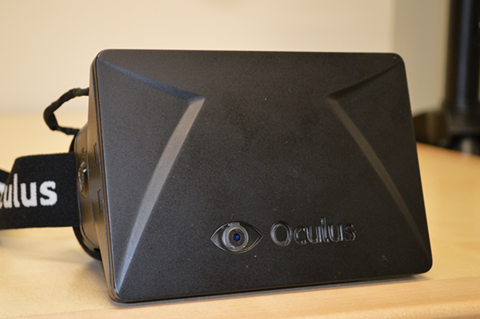It takes quite a bit to scare me. Granted, there’s a good reason for that: I’ve seen it all. The reason Shocktober’s lineup doesn’t include so many obvious films, movies that will be showing on AMC all month long, is because the moment something good comes along, I’ve consumed it. Horror is an addiction, and I’m always looking for the next high. Since my tolerance is so high, not much can grab my attention.

Enter the Oculus Rift.
There are a handful of times I’ve experienced genuine terror while experiencing a piece of horror. The basement scene in The Blair Witch Project. Going into a lake for the first time after watching Jaws. Surviving the water sequence in Amnesia: The Dark Descent. Experiencing Paranormal Activity in a tiny San Francisco theater years before its release, only knowing it was “a ghost story.” There are probably less than 10 moments in my life I’d describe as pure, whitehot fright.
And yet several moments happened on last night’s Spookin’ With Scoops stream. The Oculus Rift is a magical, terrifying device for the horror genre, and I’m both thrilled and scared to see what developers do with it when it has a chance to sink in.
We checked out several demos last night, and premium members can watch the archive here. The highlights were Don’t Let Go, Alone in the Rift, Dreadhalls, and Alone. (Yes, they are different games!) Some spoilers are going to follow, obviously, and the videos should help explain things.
Don’t Let Go should be called survival horror, as it involves making it through an increasing number of macabre visuals designed to unsettle you. I’m not arachnophobic, but I don’t care for spiders. They creep me the hell out, and an early challenge of Don’t Let Go involved watching a tarantula slowly crawl up your body. Don’t Let Go makes this particularly awful by rendering a virtual body, which means you’re looking at a shoulder with a spider crawling up when your head is pointed at your real-life shoulder. It gets worse, too, when the spider disappears from view, and the audio suggests it is now crawling around your head, and possibly investigating your ear.
Fuck. You.
Alone in the Rift opens similarly to Slender. You’re in a forest with a flashlight, and you must move forward. Note collecting is not on the agenda, though, and it’s purely about progression. Pretty early on, you come across an abandoned cabin. Upon entering the cabin, the rest of the forward disappears, there’s no way to exit the cabin, and a ghostly girl begins flickering in and out of view. You have no choice but to sit through this madness and let it pass. It was a deeply disturbing few minutes, one that I’d figured I's safely survived after exiting the cabin. The moment I’d found my breath, the image of the girl returned right in front of my face. I turned it off.
Dreadhalls showed the most potential for what the Oculus Rift can enable over a standard keyboard and mouse or gamepad. It’s a dungeon. It’s dark. By looking down, you can reference a map that’s filled in as you progress through the dungeon. Unfortunately, there are creatures stalking this dungeon, and your only option is to run away. You have no weapons, but there’s a lamp that must be refilled regularly, which means venturing further and further into the dungeon. The creatures do not only emerge by stumbling upon them, and it appears the game is aware of when the player points their head down, as it seemed to summon some of the most terrifying apparitions (one was a ghastly, bleeding woman that merely stumbled forward) when I would lift my head up. In Dreadhalls, I believe I’ve found my new Slender: a game to return to in hopes of victory.
Alone was particularly interesting. You don’t move around in this one, but instead find yourself on a couch in a living room that looks like any other living room. See, you’re actually playing a game within a game, but that game is slowly but surely revealing that it’s commenting on what’s happening in the real-world, too. Over the course of the admittedly short but effective experience, it becomes clear there are multiple presences in the house. At any time, you can stop and look around, and try to piece together what’s happening. It always seems like something is happening out of the corner of your eye, and it only takes a quick nudge of your face to try and confirm your suspicion. A fan situated right above me proved particularly distracting, and I mean that in the best way possible. It’s precisely because of Alone’s utterly mundane setting that it’s so effective.
As I went through the demos, I was sweating profusely, and had to take several breaks. I was uncomfortable, stressed out, and my shot nerves were sometimes making it hard to speak, let alone manage a live stream.
By design, the Oculus Rift destroys several coping mechanisms we use when using fright as entertainment. We tend to watch horror movies with other people, so that when a scary moment hits, we can grip someone's hand, look them in the eye, and establish ourselves back in reality. You cannot do that with an Oculus Rift. Instead, you must stare forward and remember that you are completely, utterly alone. There is no one there to bounce your emotions off of, and the only way to escape is by taking the device off.
One of my habits while playing a horror game is to generate distance between myself and the monitor. (This doesn’t happen so much with console games, but these days, there are few instances where you’re playing a horror game on a console.) I know it’s ridiculous, but giving myself a few more inches is a meaningful comfort, as it helps drive a wedge between what might appear on the screen and my physical self. WIth an Oculus Rift, moving your body around is no help. In fact, the screen is closer than ever--it’s centimeters from your eyeballs. Once again, you’re forced to suffer through the imagery, unless you physically remove it.

Were it not for a stream of 800 people watching me drive myself up a wall, I would not have kept playing those games. One or two was enough. I’d had my fill. It ceased being interesting fun and became a masochistic exercise in fulfilling my audience’s desires. Of course, that’s completely okay--it’s the reason I stream these horror games in the first place. The stream, especially the lively chat room, provided the one sense of comfort I could rely on. But I was driven to the feeling of “what am I doing this for?” much more quickly than I have been with other horror games, and the last time I seriously asked the question was playing Amensia.
There’s no other way of putting it: horror and the Oculus Rift is not for everyone. I’d highly recommend people seriously think about whether or not it’s worth experiencing. Fun is not an accurate word, and it’s for daredevil adrenaline seekers only. Scares and virtual reality are going to become a new line in the sand for some people. For example, I’ve never had much interest in going to one of those haunted houses where you’re sent alone and consent to the actors being able to touch you. (There are safe words and ways of stopping it, obviously.) That goes a step too far for me, and removes horror from a comfort zone that allows me to indulge.
But here’s what excites me so much: I’ve found an unexploited source of scares. I cannot imagine the horror highs possible with the Oculus Rift, and we’re only at the very beginning of developers finding ways of surprising us. This, like anything else, will soon run out of gimmicks, and the overreliance on jump scares will become a trope with the Oculus Rift, as it has with other horror. (Outlast, as good as it was, is very guilty of this) But we’re not there yet, and experiments like Dreadhalls and Don’t Let Go suggest there is plenty of material.
It's daytime, and my confidence has returned. Last night was scary as hell, but I'll be back for more.
